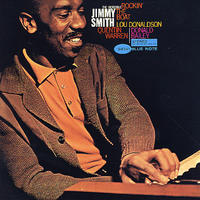 Blue Note was a cheapskate company with high standards. Normal first year sales of their albums were about 7,000. The breakeven point was about 2,500. But only about half the albums the company recorded came out at the time. Clearly, the company was profitable, since the records would sell for years, or decades, but not spectacularly so. Alfred Lion and Francis Wolf wanted to record the musicians they thought were best. To manage that, they needed to offer the musicians something they couldn’t get from other companies; and to do so within very tight budgets. They came up with the idea of a cash payment that would be greater than the standard Musicians Union scale. The kick was that there were to be no royalties.
Blue Note was a cheapskate company with high standards. Normal first year sales of their albums were about 7,000. The breakeven point was about 2,500. But only about half the albums the company recorded came out at the time. Clearly, the company was profitable, since the records would sell for years, or decades, but not spectacularly so. Alfred Lion and Francis Wolf wanted to record the musicians they thought were best. To manage that, they needed to offer the musicians something they couldn’t get from other companies; and to do so within very tight budgets. They came up with the idea of a cash payment that would be greater than the standard Musicians Union scale. The kick was that there were to be no royalties.All went well until Jimmy Smith, Donald Byrd and Lou Donaldson got records onto the pop charts. Not having read their contracts, they went to Blue Note and asked for their royalties and were told, and I quote, “fuck off, you don’t get no royalties!”
So they did. Smith was the first. He went to Verve and recoded Bashin’ and got a top 5 single out of it, as well as a top 10 album. “Oi! You’re still contracted to us!” was the immediate response from Blue Note. Smith owed Blue Note four albums under his contract. After much hassle, Blue Note got him into Van Gelder’s studio on 31 January 1963. Between then and 8 February, he cut four albums. The reissue in 2004 on CD of the last two means that they are all out again.
Blue Note did well out of those nine days; spinning out the release of the albums over four years, they got three of them onto the pop album charts. Not only were they popular; they were really very good records. Every one is a mellow, relaxed groove in which Smith doesn’t try to prove anything. Each one includes a classic blues ballad: T’ain’t No Use; Careless Love; Please Send Me Someone To Love; and I Almost Lost My Mind. These set the feeling for each album, but there are a couple of Calypsos in there; plenty of hard-rocking grooves that would have done well on juke boxes; some gospel songs like Just A Closer Walk, When The Saints Go Marching In and John Brown’s Body; none of this material was the kind of stuff that Smith usually recorded so, despite the relaxed feel to the albums, Smith and his colleagues were exploring somewhat new territory.
Apart from Bucket!, which just featured Smith’s regular trio with Quentin Warren and Donald Bailey, the albums featured other Blue Note stars, who hadn’t yet left for pastures new.
I’m Movin’ On – an obvious message – features Grant Green, and is the only one that didn’t make the pop charts, possibly because it wasn’t released until after Blue Note had been sold in 1967. The rapport between Green and Smith is astounding, since they didn’t usually play together. The CD has two extra tracks from the session that only came out on a Japanese LP.
 Rockin’ The Boat features Lou Donaldson. It’s the only one of the four that I didn’t get on LP, though I did get a 45 off the LP. It has the greatest grooves on it and no bonus tracks. It also features John Patton – playing tambourine(!) - on three tracks. Patton was in Donaldson’s band at the time and, the previous week, Lou had just recorded his last Blue Note for several years. Finally, Prayer Meetin’ features Stanley Turrentine. Turrentine had been on the two hit albums - Midnight Special and Back At The Chicken Shack - that Smith recorded on 25 April 1960, so he was an obvious choice for Smith’s farewell party. Unfortunately, the two bonus tracks on the CD were recorded in June 1960, at a duff session with, strangely, Sam Jones on bass. They really don’t fit in with the rest.
Rockin’ The Boat features Lou Donaldson. It’s the only one of the four that I didn’t get on LP, though I did get a 45 off the LP. It has the greatest grooves on it and no bonus tracks. It also features John Patton – playing tambourine(!) - on three tracks. Patton was in Donaldson’s band at the time and, the previous week, Lou had just recorded his last Blue Note for several years. Finally, Prayer Meetin’ features Stanley Turrentine. Turrentine had been on the two hit albums - Midnight Special and Back At The Chicken Shack - that Smith recorded on 25 April 1960, so he was an obvious choice for Smith’s farewell party. Unfortunately, the two bonus tracks on the CD were recorded in June 1960, at a duff session with, strangely, Sam Jones on bass. They really don’t fit in with the rest.Listening to all four albums together is wonderful. Although there are different stars taking their own approaches and a wide variety of source material, the way it’s handled shows a high degree of integration, both in the direction of the music and the relationships between the musicians. It’s about three hours of constantly satisfying groove - AM
No comments:
Post a Comment